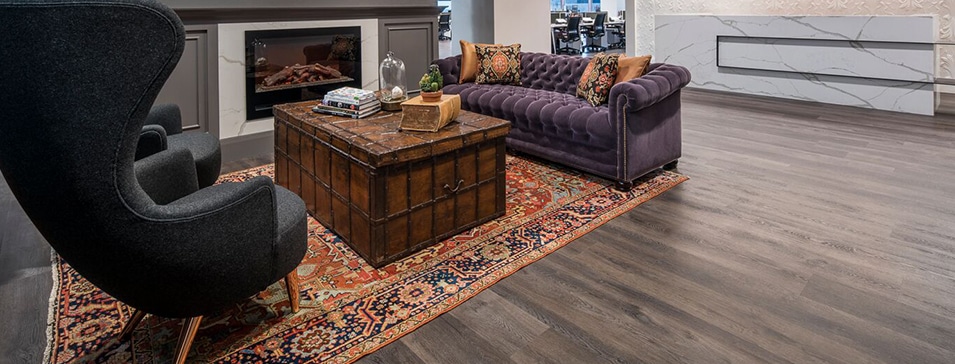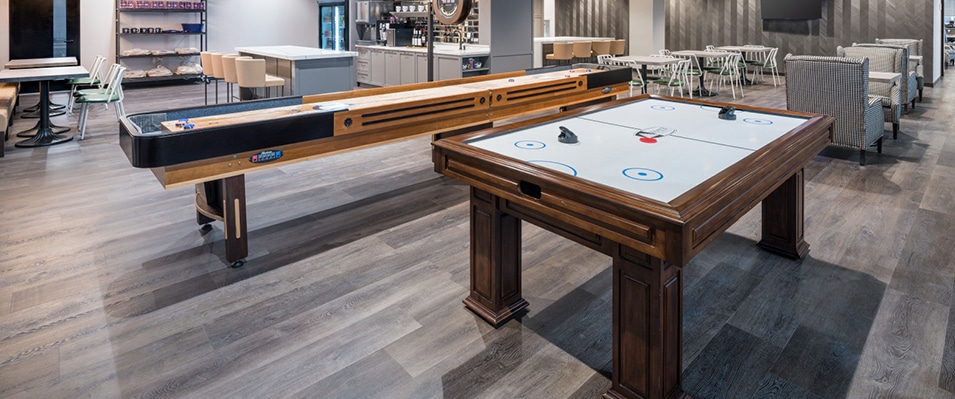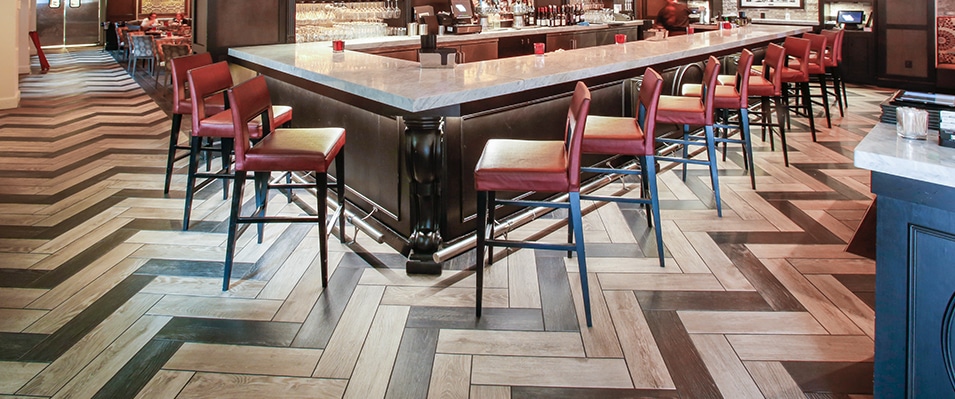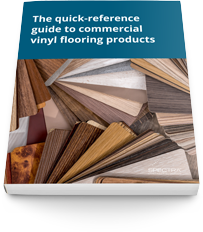Is rigid core flooring ready to be specified in commercial applications?

It’s been seven years since USFloors unveiled its COREtec product line. With the gift of hindsight, we know this was far from a routine product release. It started a new chapter in vinyl flooring innovation and launched an entirely new subcategory of luxury vinyl flooring — what we know today as rigid core flooring.
A lot has happened in those seven years. Almost every major flooring manufacturer — Mannington, Shaw, Mohawk, Interface, etc. — has jumped on the bandwagon, throwing their own rigid core products into the ring. And after confusion early on about what defined this quickly growing category, some of the biggest players came together to write agreed-upon performance standards.
Fast forward to today, and rigid core flooring has re-shaped the residential flooring market as more and more homeowners gravitate to these waterproof, sound-absorbent products.
But the commercial side has been slower to embrace this new product category. As a commercial flooring contractor, we install products in job sites across the country every day. Very few of our projects call for rigid core, and we want to draw on our field experience to explain why.

Rigid core flooring vs. luxury vinyl tile (LVT) for commercial applications
Rigid core flooring is a subcategory of LVT, and as such, the two flooring types share many characteristics. Both products can realistically imitate more expensive products (like ceramic, stone and wood) with a graphic film layer. They’re both low-maintenance — regular vacuuming and mopping regularly should suffice for lower traffic applications.
For all their similarities these are different product categories, each with their own of pros, cons and best-fit applications. And almost all differences between these product categories can be boiled down to two things: Product construction and installation.
Differences in product construction
LVT products are comprised of three layers: An outer wear layer, a graphic film layer and a base layer comprised of vinyl. Rigid products are constructed in much the same way, but with two extra layers — a rigid core (made of either foamed or solid polymer) and an attached sound-dampening underlayment.
The polymer core gives rigid core flooring products greater dimensional stability, reducing the chance of subfloor imperfections telegraphing to the surface. The underlayment improves the acoustic qualities of the flooring system and allows it to handle moisture better than your typical vinyl product.
But these technological improvements come with a sizeable price increase, barring rigid core products from serious consideration in many cost-competitive commercial projects, especially when flexible LVT has been proven to withstand the pressures of high-traffic commercial facilities.
Differences in installation
Rigid core flooring is often designed with an interlocking system — allowing each tile to “click” into place without using adhesive (called a floating or click installation).
While click installation eliminates the need to use adhesives, the thicker construction of the tiles makes it harder to cut than flexible LVT. In terms of installation labor costs, rigid core sits somewhere between LVT and wood floors. Click installation also locks the designer into a set pattern. With rigid core flooring, you can’t mix and match tile sizes and shapes to create a custom design.
On the other hand, commercial LVT is traditionally installed by adhering the tiles directly to the subfloor (called glue-down installation), giving the designer ultimate creative freedom. They can combine colors, shapes and patterns to create stunning visuals.
Beyond cost and design, glue-down installation offers superior performance in high-traffic environments. Especially in foyers, main corridors and facilities where rolling carts will pass through frequently, traditional LVT will outperform floating rigid core flooring.
Why hasn’t the commercial market embraced rigid core flooring?

Commercial flooring installation is a spec-driven business. Although we help with product selection when called upon, the lion’s share of the flooring products we install are specified by the architectural or design firm before we step foot on-site. And they select products based on design, performance and budget.
The performance improvements in the rigid core category are exciting — certainly, rigid core is superior to flexible LVT when it comes to dampening sound and handling moisture.
Those features make rigid core a perfect fit for multi-family buildings, where high Impact Insultation Class (IIC) ratings and top-down moisture resistance are key selling points. And in fact, we recommended switching the spec for an 85,000 square-foot multi-family project to a rigid core product for those very reasons.
But for almost every other commercial application, the substantial cost difference between LVT and rigid core can’t be removed from the conversation, nor can the design limitations of click installation. Not when you have flexible LVT — which is not only cheaper, but also provides greater design versatility and better withstands high traffic levels.
If a traditional, lower cost product meets all the performance requirements of a project, with superior design versatility, why pay more for bells and whistles?
To learn more about the commercial vinyl flooring market, download our quick-reference guide. You’ll receive quick takeaways about the pros, cons, price and performance of LVT, VCT and vinyl sheet flooring. Download your guide today.

Reference guide to commercial vinyl flooring products
Take the guesswork out of vinyl product selection. This guide cuts through the noise, offering you quick takeaways about the pros, cons, price and performance of LVT, VCT and vinyl sheet flooring.
